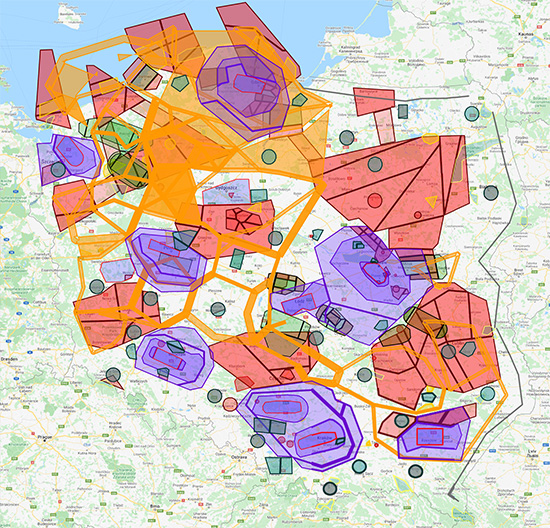Ułatwienia dostępu
Zbiór Informacji Lotniczych (AIP – Aeronautical Information Publication) dla FIR Warszawa (AIP Polska) jest publikowany i wydawany przez Polską Agencję Żeglugi Powietrznej.
AIP Polska jest opracowywany zgodnie ze standardami i zalecanymi praktykami (SARPs) zawartymi w Załączniku 15 do Konwencji o międzynarodowym lotnictwie cywilnym – Służby informacji lotniczej oraz w dokumentach uzupełniających ICAO Doc 8126 – Aeronautical Information Services Manual i Doc 10066 Procedures for Air Navigation Services – Aeronautical Information Management (PANS-AIM).
Mapy wchodzące w skład Zbioru Informacji Lotniczych (AIP) Polska, zgodne ze standardami opisanymi w Załączniku 4 ICAO do Konwencji o międzynarodowym lotnictwie cywilnym – Mapy lotnicze oraz wytycznymi zawartymi w Podręczniku map lotniczych (ICAO Doc 8697) zawierają w nazwie skrót “ICAO”, np. Aerodrome Chart – ICAO.
Odstępstwa od norm, zalecanych metod postępowania i procedur ICAO podano w rozdziale GEN 1.7.

AIP Polska jest produktem, który składa się z trzech tomów:
– AIP Polska – AIP IFR
– AIP Polska – AIP VFR
– AIP Polska – MIL AIP
Układ tematyczny informacji opublikowanych w AIP Polska jest zgodny z ICAO Doc 8126 oraz Doc 10066. Szczegółowe informacje o zawartości poszczególnych rozdziałów są podane w spisach treści.
AIP Polska publikowane jest wyłącznie w wersji elektronicznej, dostępnej przez usługę MS Sharepoint. Dodatkowe informacje dostępne są w zakładce Sprzedaż i Zamówienia.
Zmiany AIRAC do AIP Polska są wydawane zgodnie z potrzebami w terminach zgodnych z terminami cyklu AIRAC i w taki sposób, by informacja zawarta w tych zmianach dotarła do użytkownika co najmniej 28 dni (a w przypadkach szczególnych 56 dni) przed wejściem Zmiany w życie.
AIP Polska – AIP IFR jest publikowane i wydawane przez Polską Agencję Żeglugi Powietrznej. Zawiera informacje ogólne o przepisach i zasadach wykonywania lotów IFR w FIR WARSZAWA.
AIP Polska – AIP IFR składa się z następujących części:
– GEN,
– ENR,
– AD 2.
W części GEN przedstawiono informacje ogólne niezbędne do wykonywania lotów w warunkach IFR. Część ENR zawiera przepisy dotyczące ruchu IFR. W części AD 2 publikowane są informacje i mapy dotyczące lotnisk na których odbywa się ruch lotniczy IFR.
Do AIP Polska – AIP IFR wydawane są oddzielne Zmiany, Suplementy i poprawki ręczne. Wszystkie zmiany i aktualizacje wprowadzane są zgodnie z cyklem AIRAC. Mapy wchodzące w skład AIP Polska – AIP IFR nie spełniają w pełni standardów opisanych w Załączniku 4 do Konwencji o międzynarodowym lotnictwie cywilnym – Mapy lotnicze.
AIP Polska – AIP VFR jest publikowane i wydawane przez Polską Agencję Żeglugi Powietrznej. Zawiera informacje ogólne o przepisach i zasadach wykonywania lotów VFR w FIR WARSZAWA.
AIP Polska – AIP VFR składa się z następujących części:
– VFR GEN,
– VFR ENR,
– VFR AD 4.
W części VFR GEN przedstawiono informacje ogólne niezbędne do wykonywania lotów w warunkach VFR. Część VFR ENR zawiera przepisy dotyczące ruchu VFR. W części VFR AD 4 publikowane są informacje i mapy dotyczące lotnisk oraz lądowisk na których odbywa się ruch lotniczy VFR.
Do AIP Polska – AIP VFR wydawane są oddzielne Zmiany, Suplementy i poprawki ręczne. Wszystkie zmiany i aktualizacje wprowadzane są zgodnie z cyklem AIRAC. Mapy wchodzące w skład AIP Polska – AIP VFR nie spełniają w pełni standardów opisanych w Załączniku 4 do Konwencji o międzynarodowym lotnictwie cywilnym – Mapy lotnicze.
AIP Polska – MIL AIP publikowany jest przez Polską Agencję Żeglugi Powietrznej we współpracy z Szefostwem Służby Ruchu Lotniczego SZ RP. Oddział Informacji i Procedur Lotniczych Szefostwa SRL SZ RP jest odpowiedzialny za zbieranie i dostarczanie do Polskiej Agencji Żeglugi Powietrznej danych lotniczych w zakresie lotnisk wojskowych.
AIP Polska – MIL AIP zawiera informacje ogólne o przepisach i zasadach wykonywania lotów przez lotnictwo wojskowe. Produkt ten nie jest w pełni zgodny ze standardami i zalecanymi praktykami zawartymi w Załączniku 15 do Konwencji o międzynarodowym lotnictwie cywilnym – Służby Informacji Lotniczej.
MIL AIP składa się z następujących części:
– MIL GEN,
– MIL ENR,
– MIL AD 4.
W części MIL GEN przedstawiono informacje ogólne niezbędne do wykonywania lotów przez lotnictwo wojskowe. Część MIL ENR zawiera podstawowe informacje dotyczące przestrzeni powietrznej w FIR WARSZAWA oraz ogólne informacje dotyczące wykonywania lotów z widocznością i przepisów wykonywania lotów według wskazań przyrządów.
Do MIL AIP wydawane są oddzielne Zmiany, Suplementy i poprawki ręczne. Informacje kwalifikujące się do publikacji za pomocą Suplementu, a dotyczące lotnisk cywilnych oraz operacji lotnictwa cywilnego dostępne są w Suplementach do AIP Polska. Wszystkie zmiany i aktualizacje wprowadzane są zgodnie z cyklem AIRAC.
W trakcie edycji i składania AIP Polska szczególną uwagę przywiązuje się do dokładnego i poprawnego przekazania informacji. W przypadku znalezienia błędu, nieścisłości lub w razie wystąpienia jakichkolwiek wątpliwości korespondencję w tych sprawach należy kierować na niżej podany adres:
Adres pocztowy:
Polska Agencja Żeglugi Powietrznej
Służba Informacji Lotniczej
ul. Wieżowa 8
02-147 Warszawa
Polska
Tel.: +48-22-574-5625, 5624 lub 5694
Faks: +48-22-574-5619
AFS: EPWWYOYX
E-mail: ais.poland@pansa.pl
WWW: https://www.ais.pansa.pl
Polska Agencja Żeglugi Powietrznej
ul. Wieżowa 8, 02-147 Warsaw
Informacje kontaktowe:
e-mail: info@pansa.pl
tel.: + 48 (22) 574 57 06